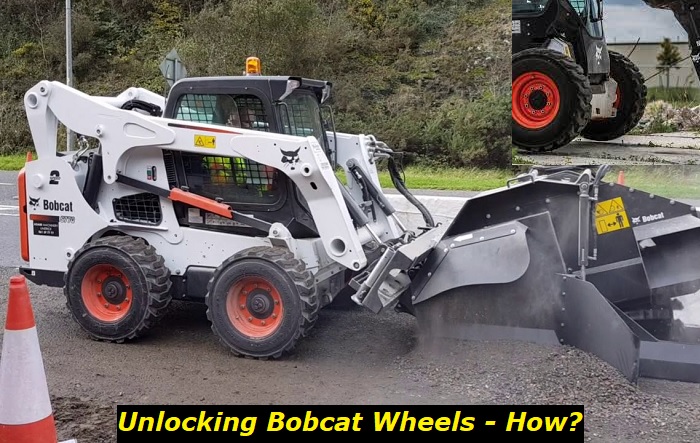How to Unlock Bobcat Wheels? Instruction and Explanation
Bobcat makes all manner of tractors. The company has been supplying quality tractors since 1947. This American company prides itself on giving its customers great value for money. Doosan Group, the parent company of Bobcat, is based in South Korea and has invested in R&D, and this has seen it rise to be a top 10 world's largest heavy equipment manufacturer.
In our article, we investigate the reason why many Bobcat owners complain the wheels won't unlock. We will look deeper into how you should unlock Bobcat wheels. In our article, you will find simple instructions and explanations for handling this Bobcat task that seems to bother many operators.

In this article, we will be using the term Bobcat to refer to a wide range of machinery from the company. Among the models under discussion include Bobcat skid-steer loaders, telehandlers, loaders. Most of the Bobcat modern equipment features the unlock wheels safety feature. This article, therefore, will be helpful to a wide number of Bobcat owners and operators.
How does Bobcat operate?
Understanding why and how the Bobcat wheels lock requires knowing how the machine works in the first place. There are several steps you should take before you start the Bobcat engine. There are other steps you are supposed to take when the engine is running, all of which prevent the wheels from locking.
Every Bobcat has safety measures put in place by the manufacturer to prevent the machine from moving. These safety measures lock the machine's operations and wheels. You may also find your Bobcat wheels remain locked when there is a malfunction.
It is imperative that you read the operator's manual if you are to operate your Bobcat machinery professionally. You will need to know how the seat bar works and when to engage and disengage the parking brake. After familiarising yourself with the operator manual, it is now time to take a look at it.
What can cause the wheels to remain locked, and how to unlock them
1) The parking brake is still engaged
Like most machinery, whether skid-wheeled, wheeled or using the track, parking brakes are installed to prevent the said machine from rolling down a hill. The parking brake is controlled by a certain coil, and if it is stuck, your Bobcat won't move. Some Bobcat operators report that the tilt and lift functions are fine, but their loader won't move forward or backwards. This symptom, together with groaning noise whenever you try to drive the Bobcat, points to a parking brake issue.
The wheels can stay locked even after physically releasing the parking brake. There is a relay that completes the parking brake circuit and whose malfunction will cause the wheels to stay locked, making your loader or skid steer immobile. Your Bobcat may also use engine speed sensor data to determine whether to release the parking brake.
When you attempt to operate your Bobcat while the parking brake is engaged, it won't move. The wheels will remain locked until you take the proper steps to release the brake. If there is a fault, whether a faulty relay or engine speed sensor, you should replace such part before attempting to operate the machinery.
2) The seat bar is not in place
When you follow the operator manual of your Bobcat, you should not have much trouble operating your machinery. When you are ready to start working with your Bobcat, it is imperative that you hook the safety belt and then engage the seat bar.
The seat bar is part of a restraining and safety system designed to keep you safe. The seat bar is linked to the pedal linkage and keeps the wheels locked when not engaged. You will also be unable to operate the blade or the boom when the seat bar is up. The operator should always lower the seat bar to place and observe all other operating instructions before commencing working with their Bobcat.
The lap bar works together with a pivoting seat bar that acts as an armrest. This seat bar, when down, keeps the operator restrained and safe in the seat. The seat bar system's interlock mechanism enables the operator to operate the foot pedals. Once the seat is up, the foot tilt and lift pedals remain engaged once the Bobcat is in neutral.
The wheels can remain locked if the seat bar, the seat safety switch or the door switch are disabled or malfunction. Other Bobcat functions, such as bucket lift, will be impossible when these safety features are disabled or are faulty. This applies to the relatively newer models of Bobcat. In some models and depending on the year of make, you can view fault codes on the hour display. Reading the codes may require you to interpret the number of light flashes on the display.
3) A malfunction of the rocker switch
The rocker switch in your Bobcat is part of the braking system. A fault with the rocker switch can make your Bobcat exhibit symptoms similar to those of a faulty parking brake. When this switch gets damaged, the wheels will fail to unlock until you remedy the problem.
To test whether the rocker switch is the problem, you should pop the switch and test for constant power supply to all the wires. If the rocker switch is the faulty part, replace it, and the locked wheels issue will be resolved. The switch is quite cheap, and with $40, you should get a new one online.
4) Hydraulic system issues
Bobcat has plenty of skid steer machinery that one can choose from. A skid steer is an easy and fun machine to operate, but it can give you issues if the system making it operable malfunctions. Skid steers use hydraulic motors to move. This means the hydraulic fluid running in the system plays a critical role in making your Bobcat operable.
There are several hydraulic motors, all of which must be working for your Bobcat to move, lift or tilt as designed. When a hydraulic motor fails, the wheels will remain locked. Sometimes, a faulty motor will cause your skid steer to move in circles. A leak in the system will also mean the wheels will not move, and when they do, they will underperform.
If the reason for the Bobcat wheels remaining locked is the hydraulic system issue, it is important that you inspect the machine first. Check for any leaks in the vales, hoses and lines. Check the fluid level in the reservoir and ensure it's not too low. Low fluid means the machine will not have the power to move or lift, especially when under load. The issue could be the hydraulic pump.
To solve a hydraulic issue affecting the movement of your Bobcat, you need to check the entire hydraulic system for leaks. Replace any malfunctioning or damaged valves, motors or pumps. Because of the sensitivity of the hydraulic system, many Bobcat owners prefer to have these issues resolved for them by authorized Bobcat dealerships.
5) Malfunctioning BICS
BICS stands for Bobcat Interlock Control System. BICS is an ingenious system from Bobcat that allows the operator to operate the machine easily. The BICS has a controller that uses a logical circuit to activate the lift, tilt and movement functions. The BICS controller requires the operator to perform a set of actions before it can be activated and unlocked.
In most instances, the BICS is not the problem but the failure of the operator to adhere to the stipulated steps in the user manual. If the seat sensor is bad or dissatisfied, you must press the 'operate' button whenever you want your Bobcat to move.
6) An electrical malfunction
Electrical power is crucial in operating your Bobcat skid steer or wheel loader. An electrical fault can cause the wheels of the machine to remain locked. For example, you will have trouble starting the engine if the battery is dead. A faulty alternator will also be problematic for you because the battery will keep dying, and you will be unable to power the machine's various functions.
An electrical problem can be easy and cheap to resolve but also expensive and complex. Several sensors and electrical parts malfunction can cause the wheels to remain locked when you try to operate your Bobcat. To get the best results, have a professional look at the problem. They will thoroughly check the wiring, sensors and electrical switches, such as the rocker switch.
Conclusion
Operating any Bobcat, whether a skid steer or other machinery, requires one to be well-versed with Bobcat terminologies and systems. In our article, we have explored why your Bobcat may fail to unlock the wheels.
At the same time, we have explained why the wheels may fail to unlock and ways to resolve this. Different Bobcats carry operation manuals that may differ based on the technology used to make them. It is, therefore, crucial that you refer to your respective manual to know how to exactly unlock your Bobcat.

Add comment